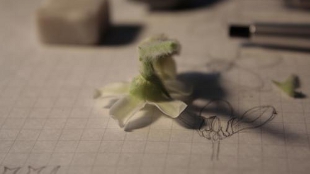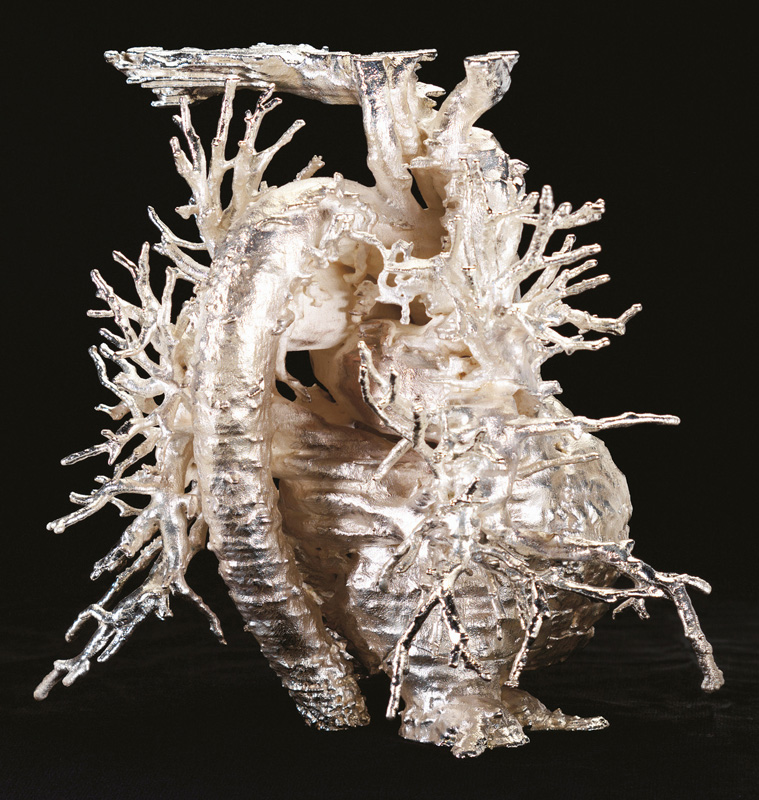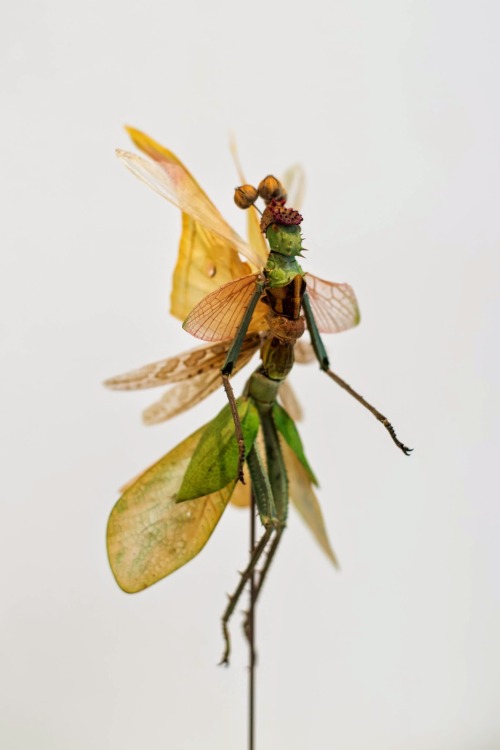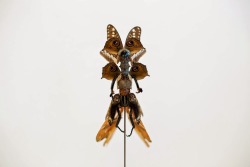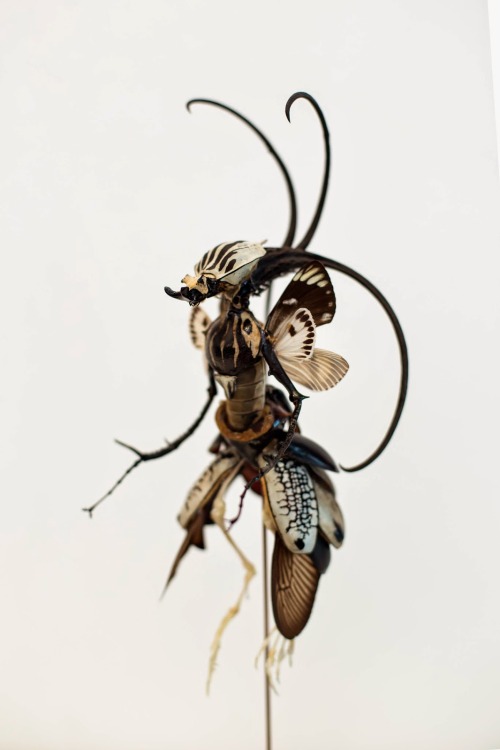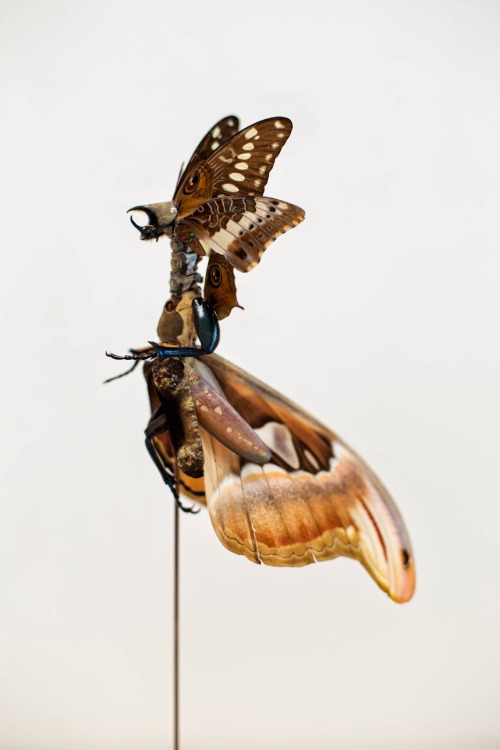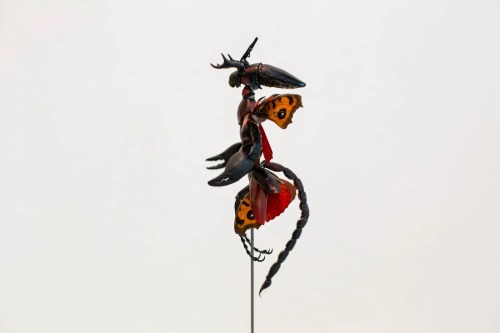BioArt is an art practice where humans work with live tissues, bacteria, living organisms, and life processes. Using scientific processes such as biotechnology (including technologies such as genetic engineering, tissue culture, and cloning) the artworks are produced in laboratories, galleries, or artists' studios.
The scope of BioArt is considered by some artists to be strictly
limited to “living forms”, while other artists would include art that
uses the imagery of contemporary medicine and biological research, or
require that it address a controversy or blind spot posed by the very
character of the life sciences.
Although BioArtists work with living matter, there is some debate as
to the stages at which matter can be considered to be alive or living.
Creating living beings and practicing in the life sciences brings about ethical, social, and aesthetic inquiry. The phrase "BioArt" was coined by Eduardo Kac in 1997 in relation to his artwork Time Capsule. Although it originated at the end of the 20th century through the works of pioneers like Joe Davis and artists at SymbioticA, BioArt started to be more widely practiced in the beginning of the 21st century.
BioArt is often intended to be shocking or humorous. One survey of the field in Isotope: A Journal of Literary Science and Nature Writing
puts it this way: "BioArt is often ludicrous. It can be lumpy, gross,
unsanitary, sometimes invisible, and tricky to keep still on the auction
block. But at the same time, it does something very traditional that
art is supposed to do: draw attention to the beautiful and grotesque
details of nature that we might otherwise never see."
While raising questions about the role of science in society, "most
of these works tend toward social reflection, conveying political and
societal criticism through the combination of artistic and scientific
processes."
While most people who practice BioArt are categorized as artists in
this new media, they can also be seen as scientists, since the actual
medium within a work pertains to molecular structures, and so forth.
Because of this dual-acceptance, the Department of Cell Biology at
Harvard University invites anyone to submit works based on scientific or
artistic value. This can encourage anyone to submit work they strongly respond to.
Monday, 25 August 2014
Building Flowers
An architecture graduate
constructs intricate botanical illustrations using the computer graphics
programs intended to design buildings.
 A SCREENSHOT FROM A VIDEO PRODUCED BY PANASONIC HOLLYWOOD LABS (PHL) FEATURING MURAYAMA'S WORK
A SCREENSHOT FROM A VIDEO PRODUCED BY PANASONIC HOLLYWOOD LABS (PHL) FEATURING MURAYAMA'S WORKWhat’s the difference between a 100-story skyscraper towering over a bustling metropolis and a 2-inch flower blooming in the countryside? To architecture-student-turned-artist Macoto Murayama, not a whole lot.
“[The flower] is organic and is rather different from architecture [in that way],” Murayama writes in an email (translated by Rodion Trofimchenko, a curator at the Frantic Gallery in Tokyo, Japan, where Murayama shows his work). “[But] when I looked closer into a plant that I thought was organic, I found in its form and inner structure, hidden mechanical and inorganic elements.”
Intrigued, Murayama began applying the computer graphics programs and techniques he had learned while studying architecture at Miyagi University of Education in Sendai to illustrate, in meticulous detail, the anatomy of flowers. After choosing a flower, purchased at the flower shop or picked up on the side of a road, he carefully dissects it, cutting off its petals with a scalpel and extracting the ovary and other internal structures. He then sketches what he sees, photographs it, and models it on the computer using 3dsMAX software, a program typically used by architects and animators. Finally, he creates a composition of the different parts in Photoshop, and uses Illustrator to add measurements and other labels.
“His images are very beautiful,” says Linda Ann Vorobik, a professional botanical illustrator affiliated with the Herbarium at University of California, Berkeley, and University of Washington, Seattle. “He’s trying to present a scientific illustration style to show the various details, but then he’s spinning it with a lot of techniques that are dependent upon high-tech tools to create images that are pleasing to the eye.”
Curator Trofimchenko first saw Murayama’s work at the Art Award Tokyo Marunouchi Exhibition in 2009. “It was, of course, not as strong as [his] recent works, but anyway outstanding: contemporary media, explicit union of tradition and experiment, and obvious root of that image in personal interest (obsession) of its author,” Trofimchenko writes in an email. Impressed, he and Frantic Gallery director Yasunobu Miyazaki approached Murayama at the opening reception and asked if he’d be interested in showing his art in the gallery.
Murayama completed his BA in spatial design at Miyagi University and a post-graduate degree in media expression at the Institute of Advanced Media Arts and Sciences (IAMAS). In addition to working on his art, he holds a part time job at a flower shop, running deliveries and assisting with production, design, and photography.
“The reason I am working at the flower shop is that I cannot support myself only with my art works, which is a negative side, but I can also see how people who deal with flowers and plants, think about them, how they perceive them, which is a positive side,” Murayama says. “I am sure that in the future this experience will come to live in my thinking and my works.”
Murayama says his current illustrations are purely an “artistic expression,” but he could see turning to more scientific endeavors down the road. Vorobik isn’t sure if his style will be easily accepted by the scientific community, however. “The reality in publication is that the bottom line matters,” she says. “For so many years, line drawings have been the cheapest way to illustrate stuff. It’s a matter of efficient cost.”
The term “New Media” is expanding,
since its emergence out of Pop Art, Fluxus, and other earlier movements,
to mean many things. It is digital, it is interactive, it is dynamic,
it is animated, it is dangerously hactivist…it is an expression of
changing times and cultures, of the horizon called the future coming
closer to us. One particular instance of New Media which has branched
out into its own discipline is “Bio Art,” such as that practiced by
British artist Jane Prophet in her project Silver Heart, seen below.
Bio Art relates not only to biological
sciences, but to engineering, robotics, and architecture, which follow
the same structural principles in building complex forms. One example
of architectural influence in Bio Art is the work of Macoto Murayama, a
graduate student from Miyagi University of Education who uses his
expertise to create beautiful, fluid forms like flowers. In speaking of
the relation between the plant and digital technology, he notes:
“[The flower] is organic and is rather different from architecture
[in that way][...][But] when I looked closer into a plant that I thought
was organic, I found in its form and inner structure, hidden mechanical
and inorganic elements.” (The Scientist, p.1). The two worlds
are, after all, not so separate. Nature and technology merge ever more
seamlessly with the integration of various disciplines into New Media
Art.
The term Bio Art was first coined by
Eduardo Kac, an American artist born in Brazil. Kac is well versed in
the fields of biotechnology and genetics, and employs his expertise in
various art projects to critique said fields of study, along with
scientific techniques in general. A good example of this strategy is
Kac’s first “transgenic” piece, “Genesis.” This work is not only an
expansion of the realm of Bio Art, but of art as a complicated series of
processes leading to a perhaps far less complicated end result. In
Genesis, the “art” lies mainly in the concept and execution: the display
is merely gloss. Kac takes this quote from the Bible: “And God said,
Let us make man in our image, after our likeness: and let them have
dominion over the fish of the sea, and over the fowl of the air, and
over the cattle, and over all the earth, and over every creeping thing
that creepeth upon the earth,” and turns it into Morse Code.
He translates that information into the base pairs, A-T, G-C of the
fundamental double helix DNA structure, then turns them into the
theoretical genetic sequences which would be created from that
data, then implants that genetic material into bacteria and swabs the
entire amalgamation onto a petri dish.
Viewers (via webcam) are given the option
to turn on a UV light above the dish, triggering mutation and
destroying the fragile links between the quote and the organisms if they
disagree with the statement therein expressed. However, in doing so
they themselves exert dominace over nature, contradicting their initial
perspective. The art lies in the dichotomous choice a viewer must make,
whether to change what he does not agree with, or conversely, be passive
about that which he holds true (for those accepting the statement would
not wish to manipulate the bacteria and destroy the statement). It
addresses the gap between human reason and action. For instance, how
does one uphold pacifism? One cannot force an invading army to stop
killing, while upholding a rule of no fighting.
Such questions, and many other interesting dilemmas, are at the forefront of exploration in Bio Art.
It is a strange direction to take, and a
strangely inverted view of the world: that the internal workings and
functions of objects such as flowers or the human body should be their
celebrated components, rather than the outer forms so praised by artists
of the past, is a perspective not merely strange, but contentious to
many. It will be interesting to see where Bio Art, and the rest of the
broadly expanding behemoth that is New Media, goes next.
References:
http://www.janeprophet.com/2011/09/rapid-prototype-sculpture-art-3d-printer-polymer-algorithn-silver-heart-2004/
http://the-scientist.com/2012/02/16/building-flowers/
http://ekac.org/geninfo2.html
John Kalymnios
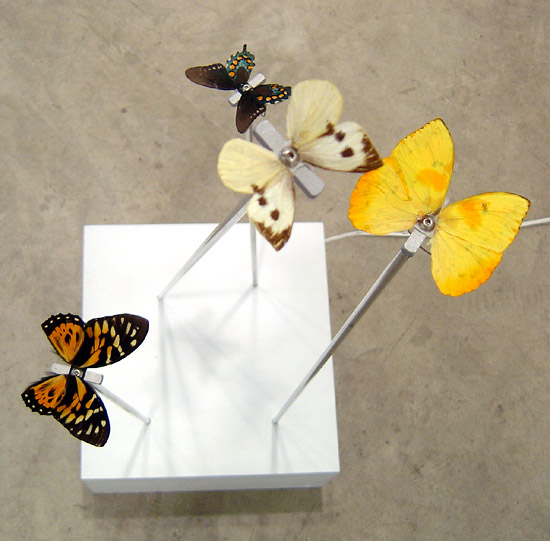
Another work:
John Kalymnios, Untitled (Butterfly) (detail), 2003
29 butterflies mounted on aluminum,
motors, each 4 1/2 X 6 inches, variable heights
Collection of Kemper Museum of Contemporary Art
Kalymnios
does not merely deconstruct nature, he perfects it. He extracts from it
the reverie and serenity it can bring us in our most elevating encounters
with it, and then frees it from the deterioration of time by adding mechanical
elements. On occasion, Kalymnios's kinetic sculptures even resurrect nature,
as with Untitled (Butterfly) (2003) in which 29 dead butterflies
are given new life. As miraculous as the new life from the cocoon in nature
may be, it is fleeting; Kalymnios, however, allows the miracle to live
on by animating the insects with the help of motorized wires. What results
is a flock of iridescent butterflies moving their delicate wings in a
simulation of flight, long after their demise. Kalymnios's ability to
eternalize the new life of the butterfly recalls Yeats's line, “Once out
of nature, I shall never take my bodily form from any living thing/but
such a form as Grecian goldsmiths make … set upon a golden bough to sing
… of what is past, passing, or to come.”
Friday, 15 August 2014
Cedric Laquieze
Amsterdam-based artist Cedric Laquieze (previously featured here) recently completed a fascinating new series of his exquisite taxidermy Fairies.
These delicate sculptures are primarily composed of parts from many
different insect species, but if you look closely you’ll notice bones,
seeds and even a few scorpion parts as well.
More here: http://laquiezecedric.blogspot.co.uk/2014/08/fairies-2014.html
More here: http://laquiezecedric.blogspot.co.uk/2014/08/fairies-2014.html
Subscribe to:
Posts (Atom)
